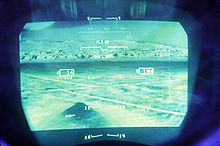
The Lockheed AC-130 gunship is a heavily armed, long-endurance, ground-attack variant of the C-130 Hercules transport, fixed-wing aircraft. It carries a wide array of ground-attack weapons that are integrated with sophisticated sensors, navigation, and fire-control systems. Unlike other modern military fixed-wing aircraft, the AC-130 relies on visual targeting. Since its large profile and low operating altitudes around 7,000 feet make it an easy target, its close air support missions are usually flown at night.

PAVE is a United States Air Force program identifier relating to electronic systems. Prior to 1979, Pave was said to be a code word for the Air Force unit responsible for the project. Pave was used as an inconsequential prefix identifier for a wide range of different programs, though backronyms and alternative meanings have been used. For example, in the helicopters Pave Low and Pave Hawk it was said to mean Precision Avionics Vectoring Equipment, but in PAVE PAWS it was said to mean Precision Acquisition Vehicle Entry.
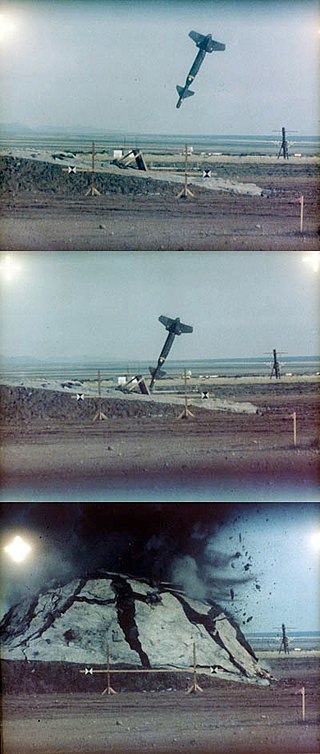
Missile guidance refers to a variety of methods of guiding a missile or a guided bomb to its intended target. The missile's target accuracy is a critical factor for its effectiveness. Guidance systems improve missile accuracy by improving its Probability of Guidance (Pg).

LANTIRN is a combined navigation and targeting pod system for use on the United States Air Force fighter aircraft—the F-15E Strike Eagle and F-16 Fighting Falcon manufactured by Martin Marietta. LANTIRN significantly increases the combat effectiveness of these aircraft, allowing them to fly at low altitudes, at night and under-the-weather to attack ground targets with a variety of precision-guided weapons.

A laser designator is a laser light source which is used to designate a target. Laser designators provide targeting for laser-guided bombs, missiles, or precision artillery munitions, such as the Paveway series of bombs, AGM-114 Hellfire, or the M712 Copperhead round, respectively.

Directional Infrared Counter Measures (DIRCM) are a class of anti-missile systems produced to protect aircraft from infrared homing missiles, primarily MANPADS and similar simple systems.

The Lockheed Martin AN/AAS-35(V) Pave Penny is a laser spot tracker carried by US Air Force attack aircraft and fighter-bombers to enable them to track a laser spot on the ground. It is a receiver only, allowing the pilot to see which targets may be attacked by any laser-guided bombs they carry.

The Westinghouse AN/ASQ-153\AN/AVQ-23 Pave Spike is an electro-optical laser designator targeting pod used to direct laser-guided bombs to target in daylight, visual conditions. It contained a laser boresighted to a television camera, which displayed its image on a cockpit screen.
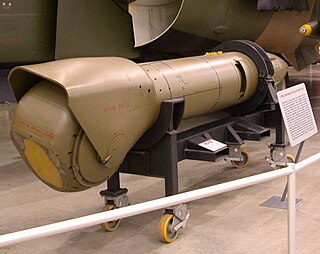
The Ford Aerospace AN/AVQ-26 Pave Tack is an electro-optical targeting pod for military attack aircraft. It uses a laser and a forward looking infrared to find and designate targets for laser-guided bombs and other precision-guided munitions. Pave Tack's images are routed to a cockpit display, usually for the weapon systems officer.

The AN/ASQ-228 Advanced Targeting Forward-Looking Infrared (ATFLIR) is a multi-sensor, electro-optical targeting pod incorporating thermographic camera, low-light television camera, target laser rangefinder/laser designator, and laser spot tracker developed and manufactured by Raytheon. It is used to provide navigation and targeting for military aircraft in adverse weather and using precision-guided munitions such as laser-guided bombs. It is intended to replace the earlier AN/AAS-38 Nite Hawk pod in US Navy service.

The Lockheed Martin Sniper is a targeting pod for military aircraft that provides positive target identification, autonomous tracking, GPS coordinate generation, and precise weapons guidance from extended standoff ranges.

The Thomson-CSF ATLIS II is a French laser/electro-optical targeting pod for fighter bomber and attack aircraft.
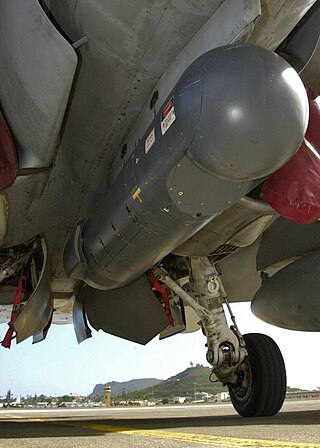
The AN/AAQ-28(V) Litening targeting pod is an advanced precision targeting pod system currently operational with a wide variety of aircraft worldwide. The research and development of the Litening was first undertaken by Rafael Advanced Defense Systems' Missiles Division in Israel, with subsequent completion of Litening I for use in the Israeli Air Force.

An infrared search and track (IRST) system is a method for detecting and tracking objects which give off infrared radiation, such as the infrared signatures of jet aircraft and helicopters.

The Lockheed Martin AN/AAS-38 Nite Hawk is a FLIR, laser designator, and laser tracker pod system for use with laser-guided munitions.
The FILAT pod is an airborne targeting pod designed to provide aircraft with all weather/night attack capabilities. It was first revealed to the public at 1998 Zhuhai Air Show, and it is designed by the 613 Institute of AVIC.
Target acquisition minefield detection system is a bomb-detection system engineered to detect improvised explosive devices (IED). It provides a unit of action (UA) asset that can be used in tactical operations in day or night, to detect and locate surface obstacles and recently buried minefields. ASTAMIDS is currently being tested in the Northrop Grumman MQ-8B Fire Scout unmanned aerial vehicle.

A precision-guided munition (PGM), also called a smart weapon, smart munition, or smart bomb, is a guided munition intended to hit a specific target, to minimize collateral damage and increase lethality against intended targets. During the Persian Gulf War guided munitions accounted for only 9% of weapons fired, but accounted for 75% of all successful hits. Despite guided weapons generally being used on more difficult targets, they were still 35 times more likely to destroy their targets per weapon dropped.
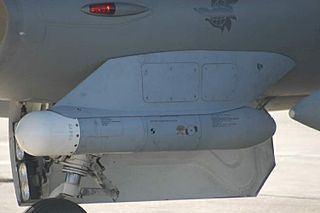
The AN/ASQ-213HARM targeting system is a targeting pod mounted to the right engine inlet hardpoint of an F-16 fighter jet that enables the aircraft to track the location of hostile radar systems in any weather, and identify them to allow for usage of the AGM-88 HARM or other air-to-ground weapons. It greatly assists in SEAD and DEAD operations, where surface to air missile (SAM) sites are being either directly attacked or threatened, and therefore suppressed, by aircraft carrying anti-radar missiles and other munitions. While the firing of anti-radar missiles is possible through the usage of HARMs in Harm As Sensor (HAS) mode, a HTS pod greatly reduces the workload of the pilot, increases the precision of the HARM, and allows for HARMs to be fired while pointed away from the SAM site being attacked when in Equation of Motion (EOM) mode.

